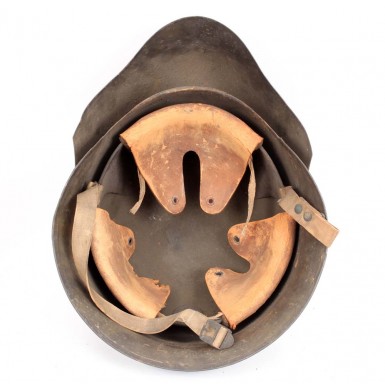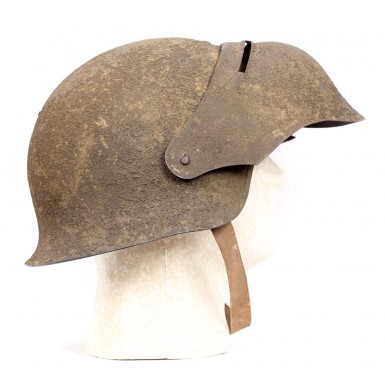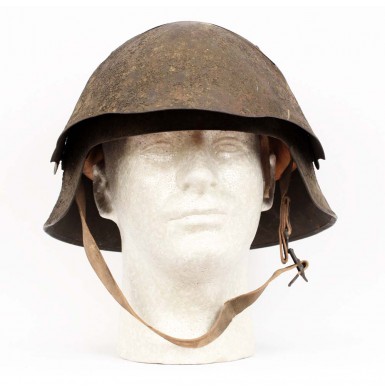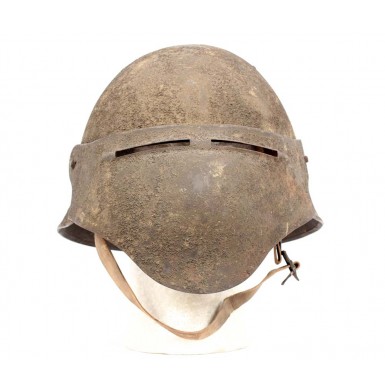Experimental US #8 Helmet - Very Fine & Very Rare
- Product Code: HMT-15-SOLD
- Availability: Out Of Stock
-
$1.00
This is a VERY FINE+ to NEAR EXCELLENT example of the very scarce World War I US Experimental Helmet #8. While the Great War was considered by most historians to be the first “modern war”, it was in fact as much a medieval war in the trenches as it was a modern one. The great technological advancements of machine guns, air warfare, tanks, and truly heavy artillery were juxtaposed by trench clubs that often resembled a knight’s mace, and a return to the use of metal helmets, which had been largely abandoned for battlefield use for nearly 300 years! The advent of somewhat reliable and effective firearms for use in the field had essentially rendered the body armor and helmets of medieval and renaissance knights obsolete. From the mid-to-late1600s onward, helmets (and body armor) saw little field use and were typically relegated to parade and ceremonial use, or combat against those who did not posses firearms. For the next 250+ years, the helmet saw little use and lost its utility as a means of protecting the head of the soldier wearing it. At the beginning of World War I, none of the combatants issued a field helmet. However, the War To End All Wars changed that, as a result of the large number of casualties due head wounds. It is reported in various sources that more than 20% of the fatal wounds suffered by the infantryman in the trenches on the Western Front were head wounds. Most of the injuries were the result of shell fragments, but some were from rifle and machine gun bullets as well. The major forces engaged in war quickly adopted metal helmets to protect the heads of their soldiers. The British Broadie M-1916 helmet (adopted in 1915) was a throw back to the chapel-de-fer or “kettle helmets’ of English pikemen, who utilized variations of that helmet from before the Battle of Hastings in 1066 through the English Civil War (1642-1651). The French M15 Adrian helmet, also adopted in 1915, was based on helmets of French heritage, with a nod towards the cuirassier dress helmets of the Napoleonic era, which were based upon their medieval ancestors. The German M-1916 Stahlhelm quickly replaced the spiked leather Pickelhaube of the late 19th century, with the classic “coal scuttle” steel helmet that became ubiquitous with Central Powers troops during WWI and (in a modified form) Axis troops during WWII. The Stahlhelm helmet was based upon 15th century Germanic Sallet helmets. Like their English and European allies and opponents, the United States entered World War I without a helmet for their troops. Early American Expeditionary Force troops utilized French Adrian helmets, which were fairly quickly replaced by English M-1916 helmets. The United States adopted their own variant of the English Broadie helmet as the US M-1917 helmet, and it remained the standard issue US infantry helmet until supplanted by the US M1 helmet at the beginning of World War II. The US high command felt that the British M-1916 helmet had a number of shortcomings, not the least of which was its poor center of gravity and an equally poor liner and suspension design. The helmet tended to shift significantly on the head when the soldier was running, which resulted in soldiers charging with one hand holding their helmets on their heads! As a result, the US high command initiated an experimental helmet design program in 1917 to develop a more effective battlefield helmet. To this end, General John “Black Jack” Pershing, commander of the American Expeditionary Force, appointed Dr. Bashford Dean to the rank of Major of Ordnance and made him Chairman of the Committee on Helmets and Body Armor. Dean was an interesting and eclectic academic who was chosen to head the committee because he was the honorary curator of Arms & Armor at the Metropolitan Museum of Art. Dean held a Ph.D. in Zoology from Columbia University, and taught that subject at Columbia as well. A self-taught expert in Medieval Arms & Armor, Dean became the curator of that department at the MET in 1912 and essentially built their entire collection. He was also a curator at the American Museum of Natural History, the only person to hold dual curatorships at both institutions simultaneously. As the Chairman of the Committee on Helmets and Body Armor, Dean oversaw the design of a number of experimental US steel combat helmets, which were simply referred to by their chronological numerical designation; 1, 2, 3, etc. Interestingly, there is no #1 helmet design known, and some researchers speculate that the M-1917 US copy of the British helmet was in fact #1. Dean’s Experimental Helmet #2 was based upon 15th century Italian and Greek helms, but had a profile quite similar to the German M-1916 helmet. Ford Motor Company produced 2,000 of these helmets in 1917, and after very limited field testing the visual similarity to the German M-1916 helmet was considered likely to cause confusion in combat and the design was abandoned. No example identified as the #3 helmet is known to exist, nor do any official drawings or design. Dean’s Experimental #4 helmet was a re-design of the British M-1916 / US M-1917 helmet. It made the bowl deeper and allowed the helmet to sit lower on the head of the soldier. Only a handful of these helmets were produced. Daniel Tachaux, who was the armorer at the Metropolitan Museum of Art, made them all. There is only one known example of this helmet in existence, and it resides in the collection of the US Army Ordnance Museum. Dean’s Experimental #5 helmet was a return to the deep bowl, all-encompassing protective design of the #2. The helmet strongly resembles the WWII M1 helmet, and was certainly the inspiration for that design. Hale & Kilburn produced 2,000 of the #5 helmets in the US, and this is the only US experimental helmet from WWI to see actual use in the trenches of France. As with the #2 design, this one was abandoned due to the strong resemblance to the German M-1916 helmet. While the #5 was initially eschewed by the US Ordnance Department, the Swiss adopted the #5 virtually unchanged from Dean’s original design. The #6 design was a one-of-a-kind prototype design that had a long fixed visor that could tilt forward on the head to protect the face, or be tilted back for a clear field of view. Doing so protected the back of the head more fully. The odd, unbalanced design left the rear of the head largely unprotected when the visor was down, and this ended any further experimentation with the #6 design. The #7 design was another medieval influenced helmet that had a deep bowl main body with moveable metal flaps that protected the sides of the wearers’ head and part of his face. The helmet was produced in three weight variants of 11, 15 and 18 pounds, but was found to be incredibly uncomfortable and unmanageably heavy. Additionally the protective flaps seriously limited the field of view of the soldier. At least a few of the #7 helmets were produced by W.H. Mullins & Company of Salem, OH, but only two examples are known today, both in museum collections. Dean tried to effectively redesign his #7 helmet as the #9, but only a single prototype was ever produced. It was Dean’s Experimental Helmet #8 that is probably the most striking of the US experimental helmets and the one that most evokes the thought of knights in shining armor. The design was based upon his deep bowl #5 helmet, but added a hinged visor to protect the face. The visor had a pair of long, narrow slits for the eyes, which allowed a very good field of view, even though they look very limiting. The visor in the down position gave the helmet a very medieval appearance, and the overall look is reminiscent of a 15th century Italian Armet. The helmet incorporated the 3-pad liner and suspension system that Dean had introduced with his #2 helmet. Three cushioning pads made of wool were attached to a steel hoop, and were covered with leather pads that were adjustable for tension. The hoop was attached to the shell of the helmet by a 3-point metal suspension and riveted in place. The US M-1917 fabric chinstrap secured the #8 helmet to the head of the soldier. The helmets were painted with a textured olive drab paint to reduce glare and reflections. In November of 1918 Ford Motor Company produced 1,300 of the #8 helmets, which were subsequently sent to France, but arrived too late to see combat use during World War I. Today, the helmets are very rarely encountered, and no more than a handful have appeared to survive to the 21st century. Of those, many are in institutional collections. While Dean designed additional experimental helmets through #15, the #8 was the last of the experimental helmets to be produced in any numbers beyond prototypes or samples.
This example of the US Experimental #8 Helmet is in VERY FINE to NEAR EXCELLENT condition. The helmet is 100% complete and correct in every way and displays wonderfully. The shell is free of any dents or dings, as is the visor. The exterior retains about 80%+ of its original glare reducing textured olive drab paint. The loss is mostly confined to the high points and areas of handling and contact. Even where the paint has worn or flaked, it is mostly the textured portion that is missing, with the underlying olive drab color remaining in place. The helmet exterior shows some scattered areas of dust, dirt and minor discoloration, all of which could probably be carefully cleaned. I have elected not to do so in order to try to keep the textured paint exterior in this untouched condition. There are also some small, scattered patches of light surface oxidation and minor discoloration. The interior of the helmet retains about 90% of its original olive drab paint as well. The visor of the helmet is complete and in wonderful condition. It moves smoothly and functions exactly as it should. The interior of the helmet retains the entire complete suspension and pad system. The original steel hoop is in place, as are all three wool cushions and the three leather pads. The wool cushions are in fine condition with little loss. The leather pads are in about good condition, and show some significant drying and flaking of their finish. They retain only about 40% of their original surface finish. The front pad shows some tearing at both ends, at the flex point where the pad meets the steel suspension hoop. The pads are all in delicate condition and should be handled carefully. The pads retain all of their original enameled metal grommets, with the exception of a single missing grommet that has torn out of the end of one of the leather flaps. The grommets were for an adjustment thong that brought the flaps together and adjusted their fit against the crown of the head. The remnants of the twill cotton adjustment tie remain in the pads. This was also a tensioning device to adjust the fit of the pads to the head. The original US M-1917 chinstrap is in place and remains fully functional. The fabric strap is somewhat stiff, but still adjusts smoothly and the stamped sheet metal closure hook still functions correctly.
Overall this is really outstanding condition example of an extremely rare US #8 Experimental Helmet. These helmets are very rarely found for sale, and when they are they are often in much more worn condition. I have actually seen helmets with only the remnants of their original lining and suspension (and significantly less original paint) sell in the $6,000.00 range. In reality it is difficult to find a #8 helmet with such a complete and fine interior as this one has. It is also equally hard to find a #8 helmet with nearly all of its original finish. Several knowledgeable collectors consider this example to be the finest example that they have ever seen. If you are a serious collector of US military helmets, this is one of the absolute “Must Have” helmets that you need for your collection. This is one of the most dramatically striking helmets to have ever been designed by the US military, and would be a perfect center piece for any advanced US helmet or Great War display.
SOLD





